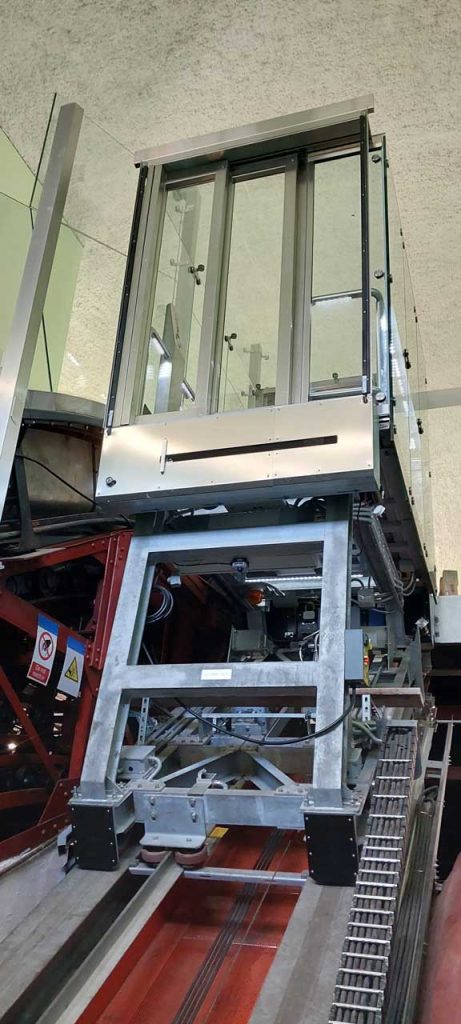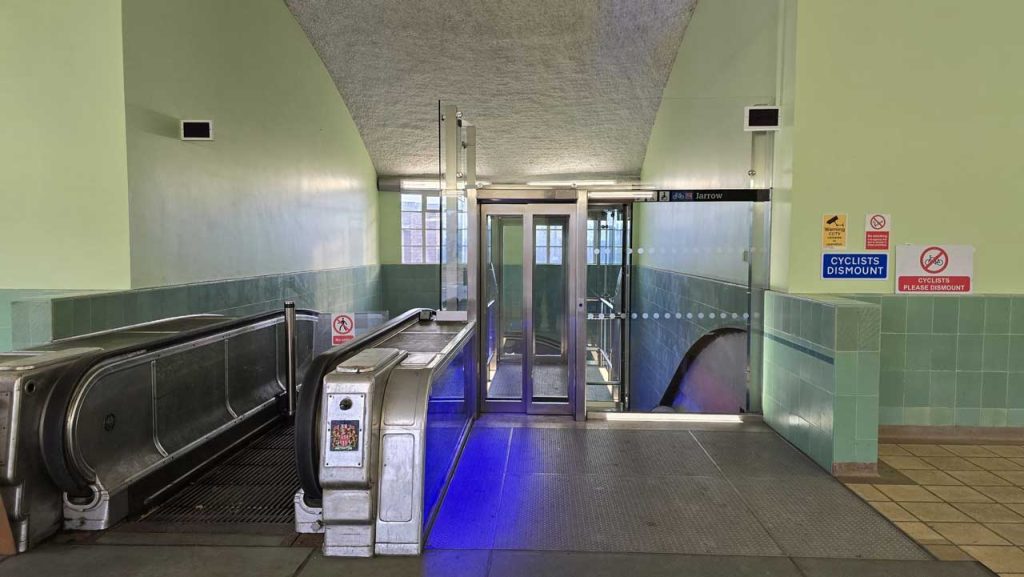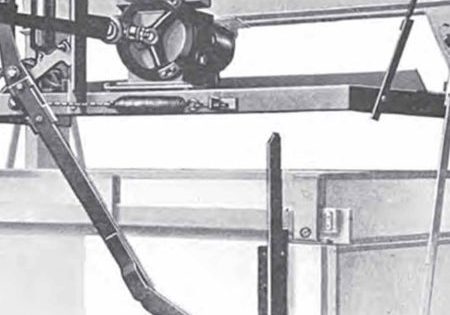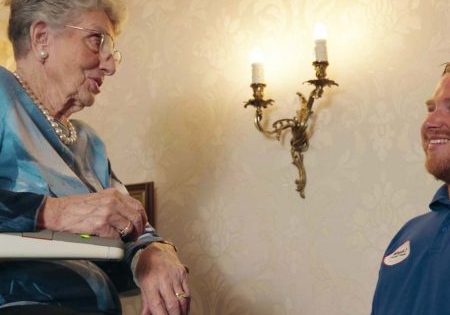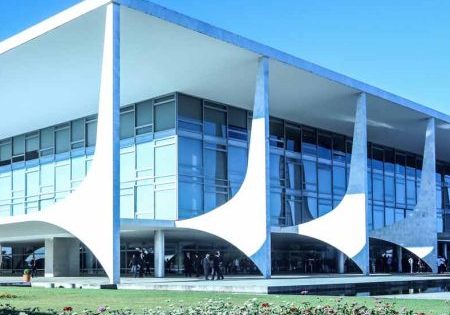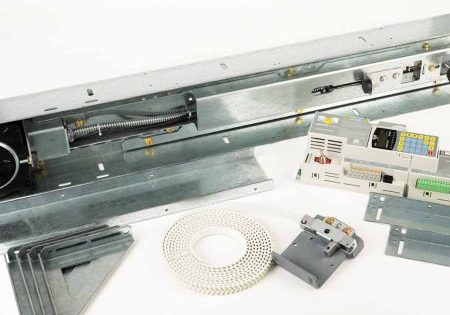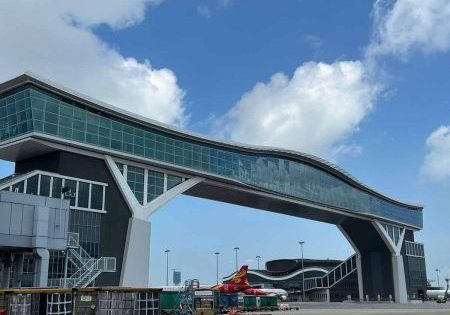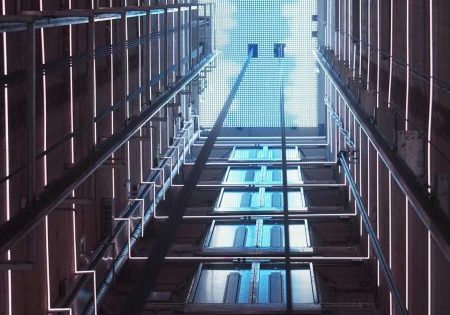Tyne Tunnel
Apr 5, 2025

Project updates vertical transportation in tunnels under the River Tyne.
by Natania Leongson
After years of preparation, the glass inclined lifts in the pedestrian and cyclist tunnels under the River Tyne are finally in operation. Archi Lift Design (Lift Design) was responsible for the final design and construction, while Netherlands-based Liftinstituut certified these one-off elevators. Paul Britton, managing director of Lift Design, shares his experiences on the project and on the collaboration with the Dutch notified body.
Since the early 1950s, the pedestrian and cyclist tunnels under the River Tyne have been vital links between North and South Newcastle. Once essential for thousands of Tynesiders commuting to shipyards and factories, the renovated tunnels now invite residents and tourists to “enjoy the experience of cycling or walking under the river – without getting their feet or tires wet!” A crucial link in the transport is two glass inclined lifts, allowing cyclists and pedestrians to travel up and down safely. On each side of the river, one of the escalators was replaced by an inclined lift.
One-off Elevators
Lift Design’s engineers and designers weren’t involved in the project from the start, Britton emphasized. Due to disagreements between the original lift builder and the client, the project experienced a temporary standstill. In 2021, Britton and his team were brought in to complete it. The client’s decision to turn to Lift Design wasn’t surprising:
“We specialize in one-off elevators — elevators that don’t already exist — so we have to get creative with clients. For example, we’ve completed some landmark projects, like a beautiful glass elevator for the Victoria and Albert Museum in London. And we’ve done a lot of private work, as well. Right now, we’re working on an interesting project with two paternoster lifts in one glass shaft, designed just for transporting rare wines.”
Challenges
According to Britton, elevators that move on an incline aren’t particularly unique. Nevertheless, the Newcastle project presented numerous challenges for Lift Design:
“Primarily because we had to work with what was already there. The lifts had not been completely installed — from structural steelwork to the equipment — so they couldn’t function as intended. Moreover, we had to retain much of the steelwork and the car frame, as the entire tunnel structure was built around them. Without access to any drawings or calculations, we really had to reverse-engineer the whole thing.”
Throughout the development, Britton worked closely with industry specialists. “We spent more than six months working with manufacturer Wittur on the doors, as the doors had to fit into an extremely tight space.” His engineers also faced issues with the ride quality due to the original design and the stability of the structure:
“We ended up working with PMT in the U.S., who provided a quality ride analyzer for elevators. With their tools and expertise, we pinpointed the exact spots causing interference. By adding bracing, making reinforcements and using different rollers, we achieved the stable ride we have now.”
“We found a lifeline in Liftinstituut for the Tyne Tunnel elevator project.”
— Paul Britton, managing director of Lift Design
Certification
For certifying the lifts in line with the European Lift Directive, Lift Design turned to Liftinstituut:
“Another notified body we often work with informed us they didn’t have the expertise or experience to assist with this specific lift. Fortunately, in Liftinstituut. The skill and understanding of their Certification Specialists Eric Verkaik and Edwin Bakker were crucial to getting the lifts certified. Their experience allowed them to review the deviations from standards, although this was by no means a routine project for them. Deviating from lift norms requires a risk analysis to justify it.”
Liftinstituut certification specialists conducted two site visits:
“During their first visit, they noted that the glass enclosures on the sides needed to be higher to prevent people from climbing onto the lift car from the escalator. In some areas, there’s only a 70-mm clearance between the top of the tunnel and the lift car. Liftinstituut provided valuable guidance and were very open to the solution we proposed. After six or seven months, they returned for final inspections. I was thrilled when I received the email confirming that the lifts were certified.”
Training Emergency Services
The project wasn’t over for Britton with certification. He was also involved in selecting the maintenance company and training the emergency services:
“If a lift breaks down on the incline and cannot be moved — a rare scenario — manual rescue by emergency services is required. It’s a dangerous spot to evacuate people. We’ve made provisions to help the emergency services manage this. During training, we showed them the most effective way to perform rescues.”
Britton reflects with pride on the project:
“On one hand, it’s unfortunate that the original engineers couldn’t complete their project — we’re fellow engineers and designers, after all. But on the other hand, I’m glad that, together with Liftinstituut and the client, we brought this vision to life. Tynesiders have an enormous fondness for this historic tunnel, and I’m pleased that we could help them to enjoy it again.”
Get more of Elevator World. Sign up for our free e-newsletter.

